人教版初中英语八年级上册Unit-7阅读课教案
- 格式:doc
- 大小:17.00 KB
- 文档页数:3

人教版英语八年级上册教案:Unit7 SectionB(2a-2e)Unit7 SectionB(2a-2e)教案【教材版本与册数】新目标人教版八年级上册【单元名称】Unit7 Will people have robots?【课时】Section B 2a-2e (第4课时)【课型】Reading(阅读课)步骤过程措施目的持续性评价1预备与激活先期知识1.Warming-up andleadingin1.T:T leads in the new words by some example sentences.The main new words: human, servant, dangerous, already, factory,Japan, believe, disagree, even, agree, hundreds of, shape, fall down...2. T: T says to the Ss “Tell your partner what you know aboutrobots. What do they look like and whatcan they do?”1.通过导入学习新单词,为后面的阅读扫清基本词汇障碍。
2.通过与同伴交流讨论自己关于机器人的相关知识,为后面的文本阅读作好铺垫。
1.进行文本阅读时,出现的新单词和短语不会给学生造成阅读障碍。
第 2 页第 3 页2 获取新知Ⅱ.Whilereading1. Fast reading . Ss Read the article and match each paragraph with thequestion it discusses.Keys of 2b:Paragraph 3 Will robots think like humans in the future?Paragraph 4 What will robots be like in the future?Paragraph 2 What can robots do today?Paragraph 1 What are robots like in movies?2.Careful reading. Ss read the whole passage after the tape, and finish the答,根据结果反馈,进行精准教学。
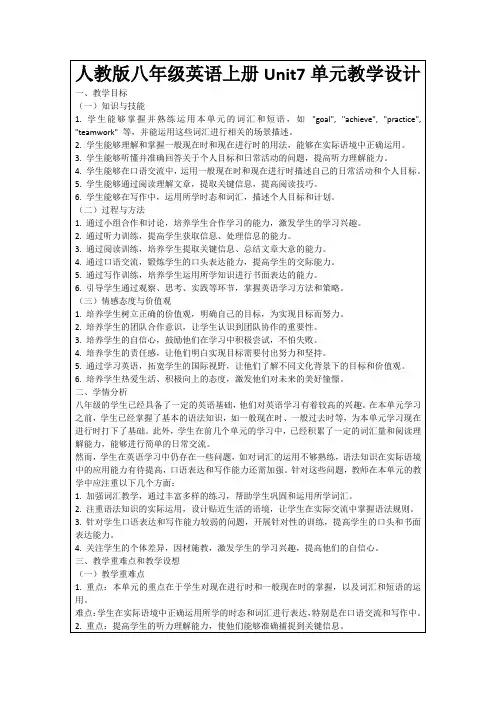
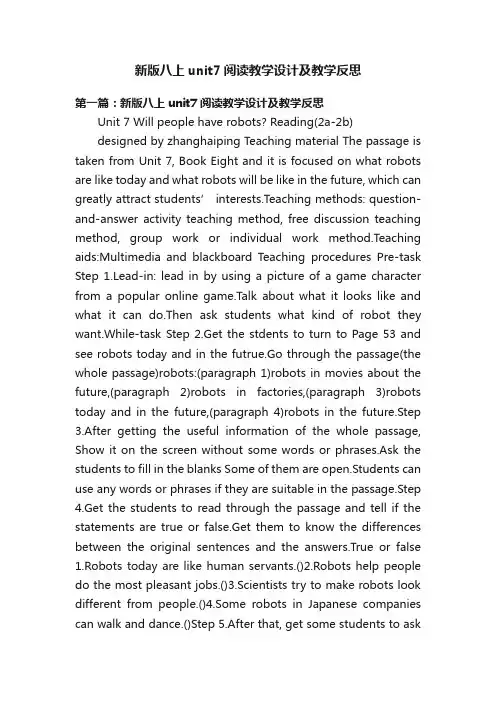
新版八上unit7阅读教学设计及教学反思第一篇:新版八上unit7阅读教学设计及教学反思Unit 7 Will people have robots? Reading(2a-2b)designed by zhanghaiping Teaching material The passage is taken from Unit 7, Book Eight and it is focused on what robots are like today and what robots will be like in the future, which can greatly attract students’ interests.T eaching methods: question-and-answer activity teaching method, free discussion teaching method, group work or individual work method.Teaching aids:Multimedia and blackboard Teaching procedures Pre-task Step 1.Lead-in: lead in by using a picture of a game character from a popular online game.Talk about what it looks like and what it can do.Then ask students what kind of robot they want.While-task Step 2.Get the stdents to turn to Page 53 and see robots today and in the futrue.Go through the passage(the whole passage)robots:(paragraph 1)robots in movies about the future,(paragraph 2)robots in factories,(paragraph 3)robots today and in the future,(paragraph 4)robots in the future.Step 3.After getting the useful information of the whole passage, Show it on the screen without some words or phrases.Ask the students to fill in the blanks Some of them are open.Students can use any words or phrases if they are suitable in the passage.Step 4.Get the students to read through the passage and tell if the statements are true or false.Get them to know the differences between the original sentences and the answers.True or false 1.Robots today are like human servants.()2.Robots help people do the most pleasant jobs.()3.Scientists try to make robots look different from people.()4.Some robots in Japanese companies can walk and dance.()Step 5.After that, get some students to askany questions they like and others can answer them.And then show some unique quesitons on the screen to see which student is the smartest.1.What kind of robots are scientists making?2.How soon will there be more robots?3.Will humans have less work to do? Why? Post-task Step 6.Write to a robot scientist to help solve your problem.Ask the students what we should write about in this paragraph.Then get them to write any sentences they like according to the two questions and then students show their own articles to others.What’s your problem? What kind of robot do you want? Step 7.The students take the following as their homework.1.Check if you can master the useful information of the passage.2.Finish the letter and prepare for next quiz.On the blackboard robots: robots in movies about the future robots in factories, robots today and in the future robots in the future.the letter: What’s your problem? What kind of robot do you want? 教学反思:《新目标英语》倡导以任务型教学,也就是引导学生通过完成具体的任务活动来学习语言,让学生为了特定的学习目的去实施特定的语言行动,通过完成特定的交际任务来获得和积累相应的学习经验。
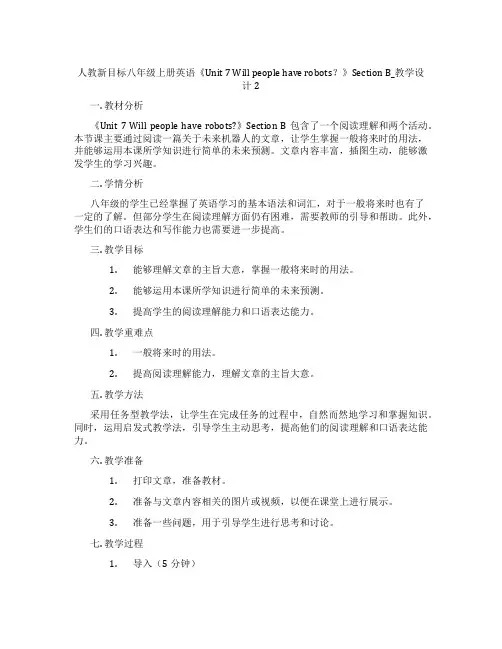
人教新目标八年级上册英语《Unit 7 Will people have robots?》Section B_教学设计2一. 教材分析《Unit 7 Will people have robots?》Section B 包含了一个阅读理解和两个活动。
本节课主要通过阅读一篇关于未来机器人的文章,让学生掌握一般将来时的用法,并能够运用本课所学知识进行简单的未来预测。
文章内容丰富,插图生动,能够激发学生的学习兴趣。
二. 学情分析八年级的学生已经掌握了英语学习的基本语法和词汇,对于一般将来时也有了一定的了解。
但部分学生在阅读理解方面仍有困难,需要教师的引导和帮助。
此外,学生们的口语表达和写作能力也需要进一步提高。
三. 教学目标1.能够理解文章的主旨大意,掌握一般将来时的用法。
2.能够运用本课所学知识进行简单的未来预测。
3.提高学生的阅读理解能力和口语表达能力。
四. 教学重难点1.一般将来时的用法。
2.提高阅读理解能力,理解文章的主旨大意。
五. 教学方法采用任务型教学法,让学生在完成任务的过程中,自然而然地学习和掌握知识。
同时,运用启发式教学法,引导学生主动思考,提高他们的阅读理解和口语表达能力。
六. 教学准备1.打印文章,准备教材。
2.准备与文章内容相关的图片或视频,以便在课堂上进行展示。
3.准备一些问题,用于引导学生进行思考和讨论。
七. 教学过程1.导入(5分钟)利用图片或视频展示未来机器人的场景,引导学生思考:Do you like robots? Why? 让学生自由发言,表达自己的观点。
2.呈现(10分钟)给学生分发文章,让他们独立阅读。
在阅读过程中,教师可适时提出一些问题,帮助学生理解文章内容。
例如:What will happen in the future?How do people feel about robots?3.操练(10分钟)学生分组,根据文章内容,进行角色扮演。
要求学生运用一般将来时进行对话,模拟未来的场景。
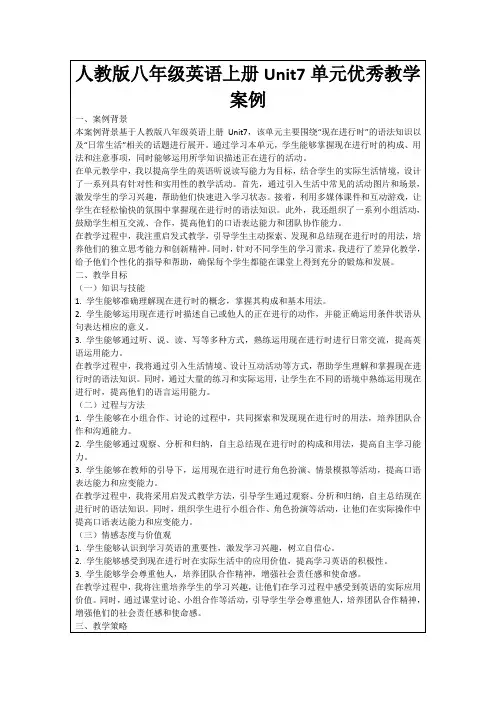
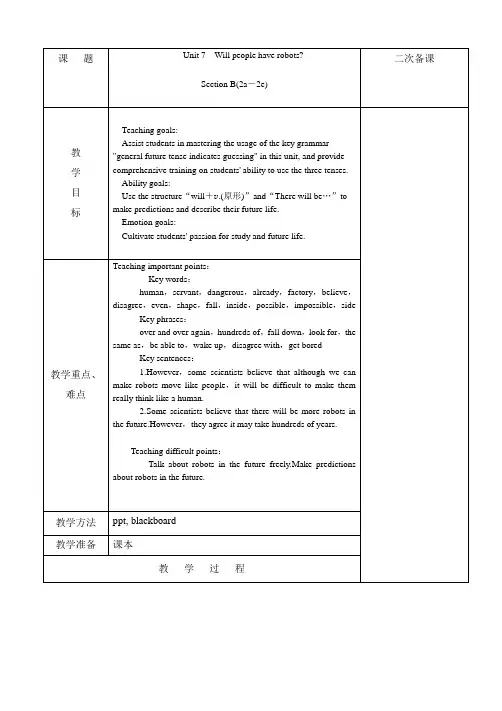
课题Unit 7Will people have robots?Section B(2a-2e)二次备课教学目标Teaching goals:Assist students in mastering the usage of the key grammar "general future tense indicates guessing" in this unit, and provide comprehensive training on students' ability to use the three tenses. Ability goals:Use the structure“will+v.(原形)”and“There will be…”to make predictions and describe their future life.Emotion goals:Cultivate students' passion for study and future life.教学重点、难点Teaching important points:Key words:human,servant,dangerous,already,factory,believe,disagree,even,shape,fall,inside,possible,impossible,side Key phrases:over and over again,hundreds of,fall down,look for,the same as,be able to,wake up,disagree with,get bored Key sentences:1.However,some scientists believe that although we can make robots move like people,it will be difficult to make them really think like a human.2.Some scientists believe that there will be more robots in the future.However,they agree it may take hundreds of years.Teaching difficult points:Talk about robots in the future freely.Make predictions about robots in the future.教学方法ppt, blackboard教学准备课本教学过程Step 1. Introduction1. Greetings.2. Have two students say something about Joe.3. Check your homework.Before Step 2 TaskAsk students to pay attention to 2a. Read the class title. Then work in pairs. Tell the other party about your understanding of robots. What they look like and what they can do, give students 5-10 minutes of time. Then select a pair of students to discuss.1. Project some pictures of robots. Have students talk about them.2. Project these new words onto the screen or write them on the blackboard, and teach them. Have students repeat over and over again. Make sure everyone knows what they mean.3. Read the classroom instructions. Give students 5 minutes to read the article and check the new words. Have students mark unfamiliar content. Then lead the students to learn the article sentence by sentence. Explain new words during this process. Pay attention to key words and phrases.4. Have students match each paragraph with the problem being discussed.5. Check the answers.6. Practice reading.Step 3 in the task1. Have students quickly reread the article. Before this, students should read through four sentences. Skip when encountering blank lines.2. Have students complete tasks independently.3. Choose 1 or 2 students to provide answers.4. Check the answers. Practice reading.5. Ask students to pay attention to two-dimensional dimensions.6. Look at the pictures and browse the main idea in the article.7. Fill in the blanks with the words from the article in 2b.8. Choose 2 or 3 S to provide the answer.9. Check the answers together.After Step 4 Task1. Choose a student to read the explanation to the entire class.2. Pairing. Discuss the following questions with your partner:(1) What kind of animals will robots be in the future?(2) What do you think these robots can do?Write your ideas on a chart.3. Choose 2 or 3 students to read their answers.4. Provide brief comments on the content written by the students.Step 5. Homework1. Review the article on page 53. Practice reading.2. How do you think robots will help you and your family in the future. Write downyour thoughts.教学反思在这节课,在通过完成任务2b来训练学生的快速阅读策略。
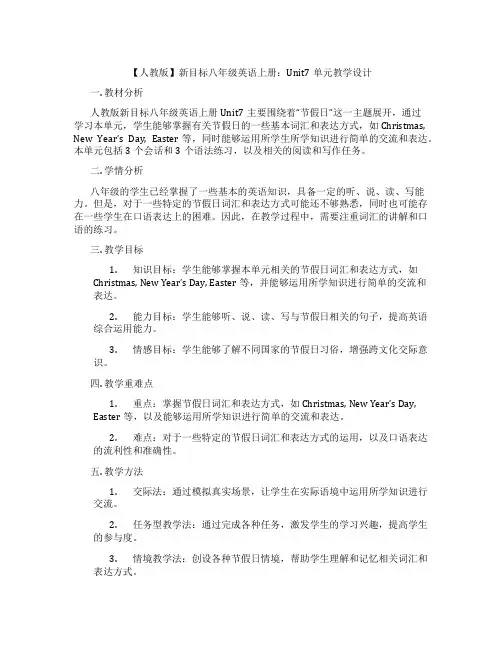
【人教版】新目标八年级英语上册:Unit7单元教学设计一. 教材分析人教版新目标八年级英语上册Unit7主要围绕着“节假日”这一主题展开,通过学习本单元,学生能够掌握有关节假日的一些基本词汇和表达方式,如Christmas, New Year’s Day, Easter等,同时能够运用所学生所学知识进行简单的交流和表达。
本单元包括3个会话和3个语法练习,以及相关的阅读和写作任务。
二. 学情分析八年级的学生已经掌握了一些基本的英语知识,具备一定的听、说、读、写能力。
但是,对于一些特定的节假日词汇和表达方式可能还不够熟悉,同时也可能存在一些学生在口语表达上的困难。
因此,在教学过程中,需要注重词汇的讲解和口语的练习。
三. 教学目标1.知识目标:学生能够掌握本单元相关的节假日词汇和表达方式,如Christmas, New Year’s Day, Easter等,并能够运用所学知识进行简单的交流和表达。
2.能力目标:学生能够听、说、读、写与节假日相关的句子,提高英语综合运用能力。
3.情感目标:学生能够了解不同国家的节假日习俗,增强跨文化交际意识。
四. 教学重难点1.重点:掌握节假日词汇和表达方式,如Christmas, New Year’s Day,Easter等,以及能够运用所学知识进行简单的交流和表达。
2.难点:对于一些特定的节假日词汇和表达方式的运用,以及口语表达的流利性和准确性。
五. 教学方法1.交际法:通过模拟真实场景,让学生在实际语境中运用所学知识进行交流。
2.任务型教学法:通过完成各种任务,激发学生的学习兴趣,提高学生的参与度。
3.情境教学法:创设各种节假日情境,帮助学生理解和记忆相关词汇和表达方式。
六. 教学准备1.教师准备:准备好相关的教学材料,如PPT、单词卡片、练习册等。
2.学生准备:学生预习本单元内容,完成相关的预习任务。
七. 教学过程1.导入(5分钟)通过提问方式引导学生谈论他们喜欢的节假日,激发学生的兴趣和积极性。
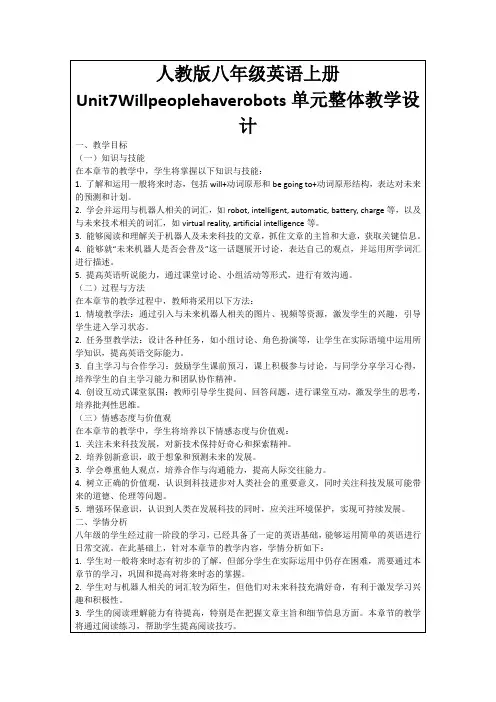

Unit 7 Will people have robots?(Section A 1a-2c)一、教材分析:(一)、本节教材的地位和作用本课是新目标英语八年级上册的第七单元的Section A 的第一部分,本节教材所涉及内容在中考中占有相当重要的地位。
本节教材围绕着“将来发生的事”展开,要求学生学习和运用“will+v(原)”构成的一般将来时态。
本课教学内容与学生的实际生活相关,可以利用学生的想象,引导学生运用简单的英语来描述将来的生活和事物。
在学习活动中,学生通过对将来发生的事情的描述,促进学生对美好未来的憧憬。
(二)、教学目标:(1)知识与技能1.指导学生学习有关将来要发生的事情的表达及语法知识点“一般将来时” 。
2.培养学生的口头表达能力、阅读理解能力和写作能力。
1. 学习有关的单词及词组:robot, paper, pollution, tree, subway, computer, will, won ’ t ,they’ll, fewer, be free, on paper, live to be, in 100 years, etc. 2. 学习重要句型:(1)People will have robots in their homes. (2)Will people have robots?. (3)Kids won’ t go to school. (4) There will be less pollution. 3. 掌握语法点:The Simple Future Tense ( 一般将来时) (1)教师自制的多媒体课件;(2)上课环境为多环境。
(2)情感目标:通过学生对自己in five years 的展望,设想自己五年,十年,甚至是二十年后的生活,贴近学生生活实际,符合学生好奇的心理,激发学生浓厚的学习兴趣。
(3) 学习策略:通过任务型的教学,让学生学会自主学习,归纳总结,培养主动学习的能力。
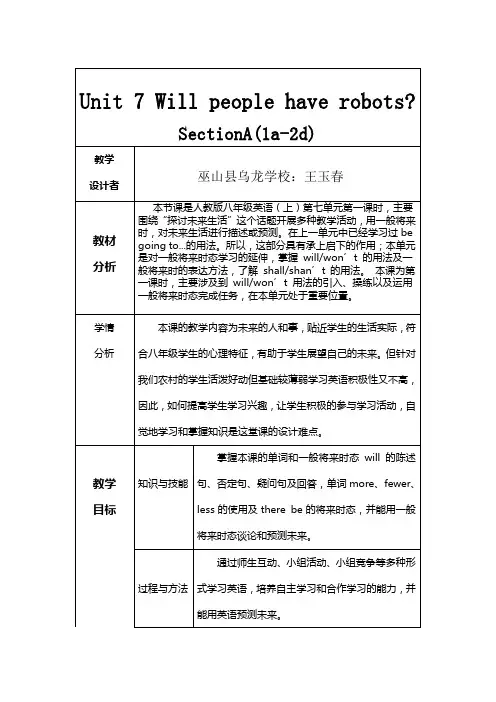
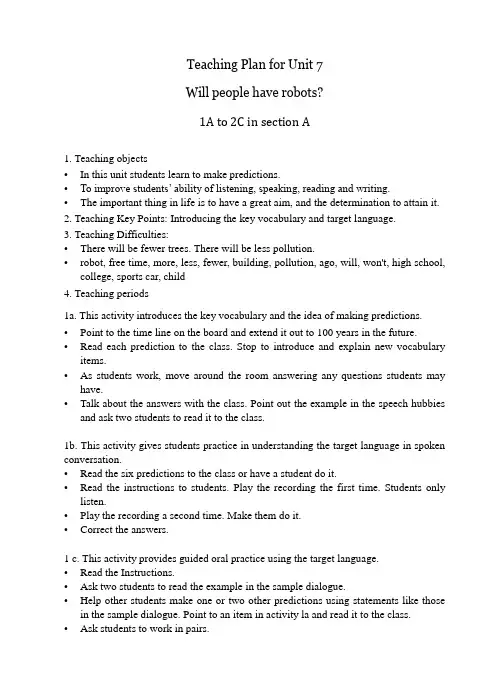
Teaching Plan for Unit 7Will people have robots?1A to 2C in section A1. Teaching objects•In this unit students learn to make predictions.•To improve students’ ability of listening, speaking, reading and writing.•The important thing in life is to have a great aim, and the determination to attain it.2. Teaching Key Points: Introducing the key vocabulary and target language.3. Teaching Difficulties:•There will be fewer trees. There will be less pollution.•robot, free time, more, less, fewer, building, pollution, ago, will, won't, high school, college, sports car, child4. Teaching periods1a. This activity introduces the key vocabulary and the idea of making predictions. •Point to the time line on the board and extend it out to 100 years in the future. •Read each prediction to the class. Stop to introduce and explain new vocabulary items.•As students work, move around the room answering any questions students may have.•Talk about the answers with the class. Point out the example in the speech hubbies and ask two students to read it to the class.1b. This activity gives students practice in understanding the target language in spoken conversation.•Read the six predictions to the class or have a student do it.•Read the instructions to students. Play the recording the first time. Students only listen.•Play the recording a second time. Make them do it.•Correct the answers.1 c. This activity provides guided oral practice using the target language.•Read the Instructions.•Ask two students to read the example in the sample dialogue.•Help other students make one or two other predictions using statements like those in the sample dialogue. Point to an item in activity la and read it to the class. •Ask students to work in pairs.•Ask several pairs to say their conversations to the class.2a. This activity provides guided listening practice using the target language.•Point out the list of predictions and ask different students to read the predictions to the class.•Read the instructions and point out the sample answer.•Play the recording. Students circle the word they hear on the recording in each sentence: more, less or fewer•Check the answers.2b. This activity provides guided listening practice using the target language.•Point to the list of predictions and ask different students to read the predictions to the class.•Read the instructions. Play the recording once. Students only listen.•Play the recording again. Students check the predictions they hear.•Check the answers.2c. This activity provide guided oral practice using the target language.•Point to the example in the sample dialogue. Ask two students to read the conversation to the class.•Point out the sentences in activity 2b. Read the dialogue again and ask students to point to the sentences that the two persons are talking about.•Then have students work in groups of four. They take turns making predictions about the future and agreeing or disagreeing with each other.•Check the answers by calling on different groups to say a conversation to the class.教学反思:现在上课基本上都使用多媒体,总的来说课堂效果比较好,但是还是遇到了一些问题:学生基础太差,虽然我已经删减了很多比较复杂的内容,但对于他们来讲,还是要花很多时间在翻译上,否则一个单词都看不懂,所以上课讲基础内容或者回忆旧知识花的时间比较多。
【人教版】新目标八年级英语上册:Unit 7 单元教学设计一. 教材分析人教版新目标八年级英语上册Unit 7主要介绍了日常生活中的规则和习惯。
本单元的主题是“遵守规则”,通过学习本单元,学生能够掌握有关日常规则的词汇和表达方式,运用祈使句和情态动词提出建议和要求,以及学会在实际生活中遵守规则。
教材内容丰富,包括听力、阅读、口语和写作等多个方面,旨在全面提高学生的英语综合运用能力。
二. 学情分析八年级的学生已经具备一定的英语基础,对于日常生活中的规则和习惯有一定的了解。
但部分学生可能在语言表达和听力方面存在困难,因此需要教师在教学过程中给予关注和指导。
此外,学生在本单元需要掌握情态动词和祈使句的用法,这对部分学生来说可能存在一定的挑战。
三. 教学目标1.知识目标:学生能够掌握有关日常规则的词汇和表达方式,正确运用祈使句和情态动词提出建议和要求。
2.能力目标:学生能够听懂、会说、会读、会写本单元的生词和重点句子,提高日常英语交流能力。
3.情感目标:学生能够认识到遵守规则的重要性,培养良好的生活习惯。
四. 教学重难点1.重点:本单元的重点是掌握有关日常规则的词汇和表达方式,以及运用祈使句和情态动词提出建议和要求。
2.难点:学生需要学会正确运用情态动词和祈使句,并在实际情境中进行运用。
五. 教学方法1.情境教学法:通过设置各种生活情境,让学生在实际语境中学习和运用英语。
2.任务型教学法:引导学生参与各种任务,提高学生的实践能力和合作精神。
3.激励评价法:鼓励学生积极参与课堂活动,给予及时的表扬和鼓励,提高学生的自信心。
六. 教学准备1.教师准备:备好本单元的教学课件、教案、听力材料等。
2.学生准备:预习本单元的生词和句子,做好上课的准备。
七. 教学过程1.导入(5分钟)教师通过提问方式引导学生谈论日常生活中遵守规则的重要性,激发学生的学习兴趣。
2.呈现(10分钟)教师展示本节课的主要内容,包括生词、短语和句子,让学生初步感知和理解。
1 / 3
初中英语八年级上册Unit 7
Will people have robots
一、本课分析
本课是一节阅读课。文本话题是机器人。通过设置读前预热、读中理解、读
后检测和拓展等活动,让学生了解机器人的由来、发展过程、对人类生活产生的
重大影响等,并把所读信息转化成对话信息,关注语言的使用。引导学生关注生
活,展望未来和相信未来,崇尚科学,探索和创造未来,从而对学生进行适当的
情感态度教育。帮助学生树立远大的理想。
(二)教学目标的确立
1. 能学会重点词汇以及目标语言。
2. 在阅读中尝试概括段落大意,加强对篇章的整体理解。
3. 在阅读过程中尝试找出文章的主线。
三、教学过程
Step I. Warming-up and lead in
Ask: What do the robots look like ?
What can they do?
Step II Fast reading
Look at the questions.
Read the article and match each paragraph with the question it
discuss.
2. Careful reading
1. Listen to the text and pay attention to the pronunciation, they c
an underline the topic sentences of each paragraph and the detail inf
ormation that they interest.
2. What can robots do in movies?
They help with housework and do jobs like working in dirty or
dangerous places.
3. Have students read the text aloud then compete the sentences below
(1). Robots can build _cars___ in factories.
2 / 3
(2).They can do __simple__ jobs many times and never get bored.
(3).Some can __walk___ and _dance____.
(4).Some can help __look for ___ people under _the buildings_____.
4.Write T or F
Scientists in Japan can make robots walk and dance.
Some scientists believe it will be difficult for robots to look
like a human
James White thinks robots can talk like humans in the future.
Step III. After-reading
(1) About whether robots can think , do scientists have the same
ideas?
(2) What are the different ideas?
(3) Which idea are you on? Say why.
StepⅣ.Homework
1. Recite the new words and expressions in the article.
2. Write a short paragraph.
For example: I want to have a robot in the future. It will look lik
e a ______. It will be able to_____, and it will also be able to help
me ____________________________
___________________... .I think I will like it very much.
3. Ask S to finish 2d-2e.
四、教学反思
本节课的设计从激发学生的兴趣开始,由易到难,逐步完成各个环节,尤其注
意文本信息的思考、评价和转换,使学生找到了学习兴趣。
不足之处: 学生参与度不够广。
部分学生依然没有养成扩大视距。
五:板书设计
Unit7 Will people have robot?
Section B 2a-2e
Do you think you will have your own robot?
3 / 3
What are robots like in movies?
What can robots do today?
Will robots think like humans in the future?
What will robots be like in the future?